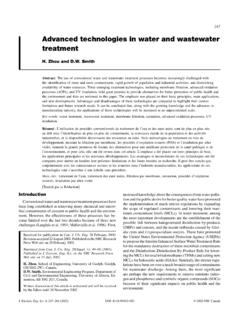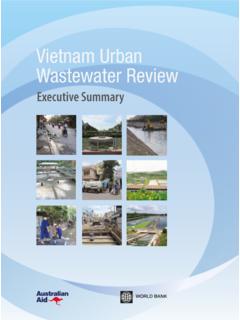Transcription of Treatment of Selenium-Containing Coal Mining …
1 An Envirogen Technologies Whitepaper August 2011 1 Treatment of Selenium-Containing Coal Mining wastewater with Fluidized Bed Reactor Technology Proven Systems Provide Major Cost Advantages and Best-in-Class Performance An Envirogen Technologies Whitepaper | August 2011 Treatment of Selenium-Containing Coal Mining Wastewaters 2 Introduction In the coal Mining industry today, selenium , in its many forms, is gaining attention. New regulations covering selenium discharge are either in place or being developed. It has been said that handling selenium wastes will increasingly become a limiting factor on the ability of the coal Mining industry to grow. While a number of physical/chemical approaches show promise in selenium Treatment , when considering optimal cost and Treatment efficacy issues, biological Treatment particularly fixed-film biological Treatment - is one of the most promising approaches to managing Selenium-Containing wastewaters.
2 Envirogen Technologies offers a patented fixed-film fluidized bed reactor (FBR) biological Treatment technology that has been proven as a best in class approach for handling medium to high flow rates of Selenium-Containing wastewater . Envirogen FBR technology has several distinct features that make it ideally suited for the coal Mining industry. The noteworthy features of Envirogen FBR technology include its ability to consistently reduce selenium levels to less than 5 g/L, shorter required residence times for Treatment and a smaller overall footprint. Its flexibility in the choice of electron donor chemicals can translate into capital and operating cost savings with reduced solids generation. It also responds well to changes in feed flow and composition, consistently achieving discharge limit conditions. In addition, these systems can be modular, with all-weather protection where desired.
3 These features, combined with decades of experience by Envirogen s team, allow the design and installation of FBR systems with capital costs that are a fraction of the cost of competitive fixed-film biological systems. The selenium dilemma Waste rock is generally the primary source of selenium in coal Mining operations. When exposed to water, various selenium species will leach or migrate from the rock and enter the environment. selenium occurs in various valence states from -2 to +6. The speciation of selenium plays a critical role in the effectiveness of any approach for removal, especially to low levels. In aqueous environments, selenium is most often found as the oxygenated anions of selenite, Se(IV) and selenate, Se(VI). selenium in mine runoff most often occurs in the soluble form . selenium is commonly found in Mining wastewaters in concentrations ranging from 3 to >12,000 g/L.
4 The US National Primary Drinking Water Standard MCL is 50 g/L for selenium . The National Fresh Water Quality Standard is 5 g/L for selenium . The Fish Treatment of Selenium-Containing Coal Mining Wastewaters 3 and Wildlife Service has recommended that the National Fresh Water Quality Standard be lowered to 2 g/L to protect fish, waterfowl, and endangered aquatic species. Several states have followed with enforcement actions at these same low levels. In Canada, permits may require stakeholders to monitor levels in water or biota, or to comply with Canadian Water Quality Guidelines of 1 g/L in surface waters. Province and local regulations may vary from these requirements. Treatment of selenium in coal Mining wastewaters presents a series of challenges. It can be present in relatively dilute concentrations and in streams with variable and often high flow rates.
5 It is present in many soluble and particulate forms, which may affect process design and treatability. The conditions of influent Selenium-Containing wastewaters can vary widely, with issues such as temperature, pH, total dissolved solids and other contaminants present, affecting the ability to selectively and economically remove selenium . Treatment of selenium often results in the generation of a concentrated by-product requiring disposal, and re-release from residuals can occur. Beyond these issues, the physical environment of coal Mining operations offers challenges such as remoteness and harsh and/or cold weather. Currently available selenium Treatment technology (Table 1) includes biological Treatment and a number of physical-chemical processes such as ion exchange, membrane filtration and adsorption that vary widely in efficiency and cost.
6 Most Treatment options remain either too costly and/or unproven for Selenium-Containing waste streams for reasons that include removal levels, variability in volume and composition of influents, system sizing and logistics considerations, as well as operating requirements. Table 1 Overview of Technologies for Removal of selenium in Water Physical Chemical Biological Reverse osmosis Iron co-precipitation Algal-bacterial Se removal Nanofiltration Zero valent iron Algal volatilization Ion exchange Cupric co-precipitation Heterotrophic microbial reduction Ferrihydrite adsorption Electrocoagulation Constructed wetlands Activated alumina adsorption Enhanced cementation Phytoremediation Photoreduction Carbohudrazide Treatment of Selenium-Containing Coal Mining Wastewaters 4 Biological Treatment of Selenium-Containing Wastewaters Biological Treatment of Selenium-Containing wastewaters has been an area of significant interest in the coal Mining community recently.
7 In general, biological Treatment offers a low cost alternative to more expensive physical and chemical Treatment methods and is effective in cold climates. Additionally, it has the proven ability to meet regulatory selenium limits. Biological systems catalyze the reduction of selenium . Selenate can be reduced to selenite, and both selenate and selenite can be reduced to elemental selenium . SeO42- + organic carbon SeO32- + organic carbon Se0 + CO2 + H2O These reactions are desirable because elemental selenium is virtually insoluble and therefore can be removed from the environment through conventional liquid/solids separation and disposal. In biological Treatment , the conversion of selenium anions to elemental selenium is accomplished via biologically catalyzed reduction. selenium -reducing bacteria (Figure 1) are considered heterotrophic.
8 They utilize organic carbon as their electron donor and selenate/selenite as their electron acceptors. Commonly used electron donor materials include methanol, acetate, citric acid and molasses. New designer electron donors, generally composed of complex carbohydrates and organic process by-products that have been proven effective for selenium reduction and precipitation, are also available. Figure 1: selenium Reduction & Precipitation One of the major issues in biological Treatment of selenium is the presence of other anions in the influent streams. Both oxygen and nitrate are more favorable electron acceptors than oxidized forms of selenium . Figure 2 shows common anions and their order of biological reduction based on ORP. The order use of electron acceptors follows the more energetically favorable reactions first. Also, reduction enzyme systems appear to have evolved such that reduction enzymes are generally inhibited by electron acceptors that are more energetically favorable, particularly if the microorganism contains more than one reduction system.
9 Treatment of Selenium-Containing Coal Mining Wastewaters 5 Figure 2: Redox Profile of Biological Reduction From a practical standpoint, these relationships are critical. The presence of either oxygen or nitrate will limit selenium reduction. Even in anoxic biological systems, the presence of nitrates is an important consideration in system design and the selection of microorganisms and electron donors. Many coal Mining wastewaters contain high levels of nitrate that will be preferentially reduced before selenium , and must be removed before effective selenium reduction will occur. Sufficient electron donor material is required to reduce both nitrate and selenium . The FBR process offers the potential benefit of denitrification and selenium reduction in a single step. Active, fixed-film biological Treatment systems have received significant attention from researchers and the coal Mining community because of their potential to work with a broad range of selenium concentrations in wastewaters including very dilute streams and for their ability to reduce selenium to very low levels.
10 These outcomes are due to the fact that the heterotrophic bacteria are retained in the bioreactor for relatively long periods of time, improving the chance that they will come in contact with the contaminants and the ability of these systems to control reaction conditions more precisely. Additionally, because of the tendency of the microbes to attach to the solid media and to form dense biomass films, these reactors can have high biomass concentrations. This is especially the case with the Envirogen FBR technology. Treatment of Selenium-Containing Coal Mining Wastewaters 6 Today, there are two different types of active, fixed-film systems that have received significant field testing with Selenium-Containing coal Mining wastewaters the fixed-film downflow filter (also known as a packed bed reactor PBR) and the fluidized bed reactor (FBR).









